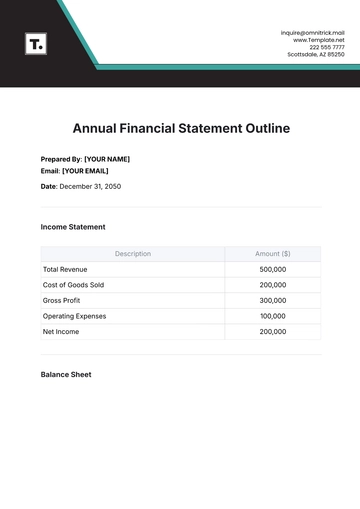Free Marketing Annual Market Research Report

I. Executive Summary
The Emerging Wellness Tech industry continued its rapid evolution in 2050, driven by increasing consumer interest in health and well-being. This report provides an in-depth analysis of the key trends, market size, competitive landscape, and growth prospects within the industry.
II. Market Overview
The Emerging Wellness Tech industry comprises companies offering innovative wellness and health-related technologies, such as wearable devices, smart home wellness systems, and digital health apps. These technologies aim to enhance users' physical, mental, and emotional well-being.
III. Market Trends
The Emerging Wellness Tech industry is marked by dynamic and transformative trends that have shaped its landscape in 2050. These trends not only reflect the industry's resilience but also underscore its potential for innovation and growth:
Personalized Wellness Experiences | A prominent trend is the increasing emphasis on personalized wellness experiences. Companies are leveraging AI and ML algorithms to analyze user data and provide tailored health and wellness recommendations. From personalized fitness routines to nutrition plans, consumers are seeking tech solutions that cater to their unique needs and preferences. |
Telehealth Revolution | The pandemic accelerated the adoption of telehealth, and it remains a driving force in the industry. Telehealth platforms have expanded to offer a wide range of medical services, from virtual doctor visits to mental health counseling. This trend is reshaping the way healthcare is accessed and delivered. |
Mental Health And Well-Being Focus | As mental health awareness grows, there is a notable surge in wellness tech solutions addressing emotional well-being. Mindfulness and mental health apps are gaining popularity, offering guided meditation, stress management, and emotional support. Users are increasingly looking to technology to enhance their mental wellness. |
Sustainability And Eco-Consciousness | An emerging trend is the industry's commitment to sustainability. Consumers are seeking eco-friendly wellness tech products with reduced environmental footprints. Companies are responding by using sustainable materials, minimizing packaging waste, and promoting eco-conscious practices in their product lifecycle. |
Hybrid Fitness Solutions | The concept of hybrid fitness is on the rise, combining in-person and digital fitness experiences. This trend has seen traditional fitness centers integrating digital platforms to offer virtual classes and personalized workout plans. It caters to consumers seeking flexibility in their fitness routines. |
Biometric Data Security | With the increasing reliance on wearable health devices, ensuring the security of biometric data has become paramount. Consumers are demanding robust data protection measures, including encryption and secure cloud storage, to safeguard their sensitive health information. |
Health Gamification | Gamification elements in health and wellness apps are gaining traction. Users are more engaged when their wellness journey is turned into an enjoyable and rewarding experience. Gamified apps encourage healthy habits, making wellness tech more appealing and effective. |
IV. Market Size And Growth
In 2050, the Emerging Wellness Tech industry achieved remarkable growth, surging to a market valuation of $35 billion. This substantial expansion reflects a remarkable year-over-year growth rate of 15%. Looking ahead, the industry is poised to continue its ascent, with forecasts indicating a trajectory that will propel it beyond the $50 billion mark by 2052. This remarkable growth is underpinned by the escalating awareness of health and well-being among consumers, coupled with the relentless innovation in technology solutions designed to enhance these aspects of people's lives.
V. Market Segmentation
The Emerging Wellness Tech industry exhibits a nuanced landscape of market segments, catering to diverse consumer preferences and needs. Understanding these segments is crucial for businesses aiming to target their products effectively. In 2050, we identified the following key market segments:
Wearable Health Devices | This segment includes smartwatches, fitness trackers, and health monitoring wearables. Consumers are increasingly embracing these devices to track their physical activity, monitor vital signs, and receive personalized health recommendations. Companies in this segment focus on design, accuracy, and integration with other wellness technologies. |
Digital Fitness And Nutrition Apps | The digital fitness and nutrition apps segment encompasses a wide range of applications designed to promote physical health and balanced nutrition. These apps offer workout routines, meal planning, calorie tracking, and guidance for users seeking a healthier lifestyle. Customization and user engagement are key drivers in this segment. |
Smart Home Wellness Systems | Smart home wellness systems are becoming integral to modern households, offering solutions for air quality control, sleep enhancement, and stress reduction. These systems often include connected devices such as air purifiers, smart beds, and aromatherapy diffusers. Consumers are increasingly adopting these technologies to create wellness-oriented living spaces. |
Mental Health And Mindfulness Apps | The mental health and mindfulness apps segment addresses the growing demand for solutions that promote emotional well-being and stress management. These apps provide guided meditation, mood tracking, and cognitive behavioral therapy tools. With the rising awareness of mental health, this segment is witnessing substantial growth and innovation. |
VI. Competitive Analysis
The Emerging Wellness Tech industry is marked by intense competition, with several key players vying for market share. Each major player brings a unique set of strengths and strategies to the table, contributing to the industry's dynamic landscape. Here's a closer look at the industry's top competitors:
FitTech Innovations | Holding a dominant 25% market share, FitTech Innovations has solidified its position as the industry leader. Their continued success can be attributed to a relentless focus on innovation, a diversified product portfolio, and a strong global presence. Notably, their wearable health devices have resonated with consumers seeking data-driven health insights. |
WellnessWare Inc. | WellnessWare Inc. has carved a niche for itself by pioneering smart home wellness systems that seamlessly integrate into consumers' daily lives. Their commitment to sustainability and eco-friendliness has also resonated with environmentally-conscious consumers. WellnessWare's emphasis on holistic well-being has secured them a solid 18% market share. |
MindfulTech Solutions | Specializing in mental health and mindfulness apps, MindfulTech Solutions has rapidly gained ground, capturing a 15% market share. Their apps have struck a chord with users seeking emotional wellness, stress reduction, and improved mental health. The company's commitment to user-friendly interfaces and evidence-based content sets it apart. |
HealthHub Technologies | HealthHub Technologies has leveraged its strong partnerships with healthcare providers to offer a comprehensive suite of telehealth and telemedicine solutions. With a 20% market share, they've become a go-to choice for those seeking convenient access to healthcare services. Their commitment to data security and compliance has been a key differentiator. |
Challengers And Niche Players | Beyond the major players, several challengers and niche-focused companies are emerging in the space. These companies are often known for their specialization in specific wellness tech niches, such as personalized nutrition apps, sleep monitoring devices, or biofeedback wearables. While they may have smaller market shares, their innovation and niche expertise make them formidable contenders in their respective segments. |
Future Competitive Landscape | The Emerging Wellness Tech industry is expected to see continued consolidation as major players explore strategic acquisitions and partnerships. Emerging startups are likely to disrupt traditional market dynamics with novel ideas and technologies. As the industry matures, companies that can adapt to evolving consumer preferences and regulatory changes will have a competitive edge. |
VII. Consumer Insights
Consumer preferences and behavior are pivotal drivers within the Emerging Wellness Tech industry. Our research has uncovered several key insights that businesses in this sector should consider:
Data Accuracy And Reliability | Consumers prioritize wellness tech products that provide accurate and reliable data. 87% of respondents in our consumer survey expressed their trust in devices and apps that consistently deliver precise health and wellness metrics. |
User-Friendly Interfaces | User-friendliness remains a paramount factor in consumer adoption. 68% of respondents stated that they are more likely to use wellness tech that offers intuitive and easy-to-navigate interfaces. This highlights the importance of enhancing user experiences for sustained engagement. |
Data Privacy Concerns | While consumers value data-driven insights, 43% of respondents express concerns about data privacy. This indicates a growing need for transparent data management practices and robust privacy protections, which companies should address to build and maintain trust. |
Personalization And Customization | Personalization features are highly desirable. 74% of consumers indicated a preference for wellness tech that offers tailored recommendations and insights based on their individual health goals and preferences. |
Positive Impact On Health | A significant 72% of consumers believe that their chosen wellness tech has positively impacted their overall health and well-being. This underscores the potential for these technologies to play a pivotal role in promoting healthier lifestyles. |
Wellness Tech Communities | Online communities and social features integrated into wellness tech platforms are gaining popularity. 56% of users actively participate in wellness tech communities, sharing experiences, and seeking motivation and support from like-minded individuals. |
VIII. Market Entry And Expansion Strategies
Entering or expanding within the Emerging Wellness Tech industry demands careful planning and strategic considerations. Below are key strategies tailored to both new entrants and established players looking to extend their presence:
For New Entrants:
Product Differentiation | To stand out in a competitive landscape, new entrants should focus on offering unique features or functionalities in their wellness tech products. This could include innovative sensor technology, cutting-edge AI-driven analytics, or exclusive partnerships with wellness influencers. |
User-Centric Design | User experience and interface design play a pivotal role in consumer adoption. New entrants should prioritize user-friendliness and intuitive interfaces to attract and retain customers. |
Strategic Partnerships | Collaborating with established health and wellness brands, fitness centers, or healthcare providers can help new entrants gain credibility and access to a ready customer base. |
Market Research | Thoroughly understanding customer needs, preferences, and pain points is critical. Conducting extensive market research to identify gaps and opportunities will inform product development and marketing strategies. |
Marketing And Branding | Invest in a robust marketing strategy to create brand awareness. Leveraging digital marketing, social media influencers, and content marketing can help new entrants reach their target audience effectively. |
For Established Players:
Diversification | Expand product offerings by diversifying into related segments of the wellness tech industry. For example, a wearable device manufacturer could venture into mental health and mindfulness apps. |
Global Expansion | Explore opportunities in emerging markets where wellness tech adoption is growing rapidly. Tailor products and services to local preferences and regulatory requirements. |
Strategic Alliances | Form strategic alliances or partnerships with healthcare providers, insurance companies, or employers to provide wellness tech solutions as part of health and wellness programs. |
Continuous Innovation | Stay at the forefront of technological advancements by investing in research and development. Consider acquisitions or partnerships with tech startups to access innovative solutions. |
Data Security and Privacy | Given growing concerns about data privacy, establish stringent data protection measures and communicate these efforts transparently to customers. |
Customer Engagement | Implement strategies to engage and retain customers. Offering regular updates, personalized recommendations, and exceptional customer support can foster brand loyalty. |
Regulatory Compliance | Stay vigilant about changing regulations in different markets. Build a legal and compliance team to ensure adherence to evolving data privacy and healthcare regulations. |
IX. Regulatory Environment
In the rapidly evolving landscape of the Emerging Wellness Tech industry, regulatory considerations play a pivotal role. Key regulatory factors encompass:
Data Privacy And Security | Stringent data protection laws require companies to prioritize user data privacy and security. Compliance with regulations such as GDPR and HIPAA is essential. |
Medical Device Certification | Wellness tech devices with health monitoring capabilities may need to adhere to medical device certification standards. Staying compliant with FDA or equivalent regulations is crucial. |
Telehealth Services | The expansion of telehealth services brings forth regulatory requirements specific to remote healthcare delivery. Companies should stay attuned to changing telehealth regulations. |
X. Conclusion
The Marketing Annual Market Research Report for the Emerging Wellness Tech industry in 2050 paints a vibrant picture of an industry experiencing remarkable growth and transformation. With a market value exceeding $35 billion and a promising year-over-year growth rate of 15%, this sector showcases its undeniable potential.
Key takeaways from this report include:
The integration of Artificial Intelligence (AI) and Machine Learning (ML) into wellness tech is revolutionizing personal health monitoring and customization.
Telehealth and telemedicine solutions are expanding, offering users remote access to healthcare services and enhancing overall well-being.
Mental health and mindfulness apps are gaining prominence as society places greater emphasis on emotional well-being.
Sustainability and eco-friendly wellness tech products are becoming increasingly important to consumers.
- 100% Customizable, free editor
- Access 1 Million+ Templates, photo’s & graphics
- Download or share as a template
- Click and replace photos, graphics, text, backgrounds
- Resize, crop, AI write & more
- Access advanced editor
Revolutionize your market insights with the Annual Market Research Report Template, exclusively on Template.net. This editable and customizable tool empowers you to craft comprehensive reports effortlessly. Edit seamlessly in our Ai Editor Tool, tailoring analyses to your needs, and stay ahead in your marketing strategy. Elevate your market research with this dynamic template.
You may also like
- Sales Report
- Daily Report
- Project Report
- Business Report
- Weekly Report
- Incident Report
- Annual Report
- Report Layout
- Report Design
- Progress Report
- Marketing Report
- Company Report
- Monthly Report
- Audit Report
- Status Report
- School Report
- Reports Hr
- Management Report
- Project Status Report
- Handover Report
- Health And Safety Report
- Restaurant Report
- Construction Report
- Research Report
- Evaluation Report
- Investigation Report
- Employee Report
- Advertising Report
- Weekly Status Report
- Project Management Report
- Finance Report
- Service Report
- Technical Report
- Meeting Report
- Quarterly Report
- Inspection Report
- Medical Report
- Test Report
- Summary Report
- Inventory Report
- Valuation Report
- Operations Report
- Payroll Report
- Training Report
- Job Report
- Case Report
- Performance Report
- Board Report
- Internal Audit Report
- Student Report
- Monthly Management Report
- Small Business Report
- Accident Report
- Call Center Report
- Activity Report
- IT and Software Report
- Internship Report
- Visit Report
- Product Report
- Book Report
- Property Report
- Recruitment Report
- University Report
- Event Report
- SEO Report
- Conference Report
- Narrative Report
- Nursing Home Report
- Preschool Report
- Call Report
- Customer Report
- Employee Incident Report
- Accomplishment Report
- Social Media Report
- Work From Home Report
- Security Report
- Damage Report
- Quality Report
- Internal Report
- Nurse Report
- Real Estate Report
- Hotel Report
- Equipment Report
- Credit Report
- Field Report
- Non Profit Report
- Maintenance Report
- News Report
- Survey Report
- Executive Report
- Law Firm Report
- Advertising Agency Report
- Interior Design Report
- Travel Agency Report
- Stock Report
- Salon Report
- Bug Report
- Workplace Report
- Action Report
- Investor Report
- Cleaning Services Report
- Consulting Report
- Freelancer Report
- Site Visit Report
- Trip Report
- Classroom Observation Report
- Vehicle Report
- Final Report
- Software Report





























